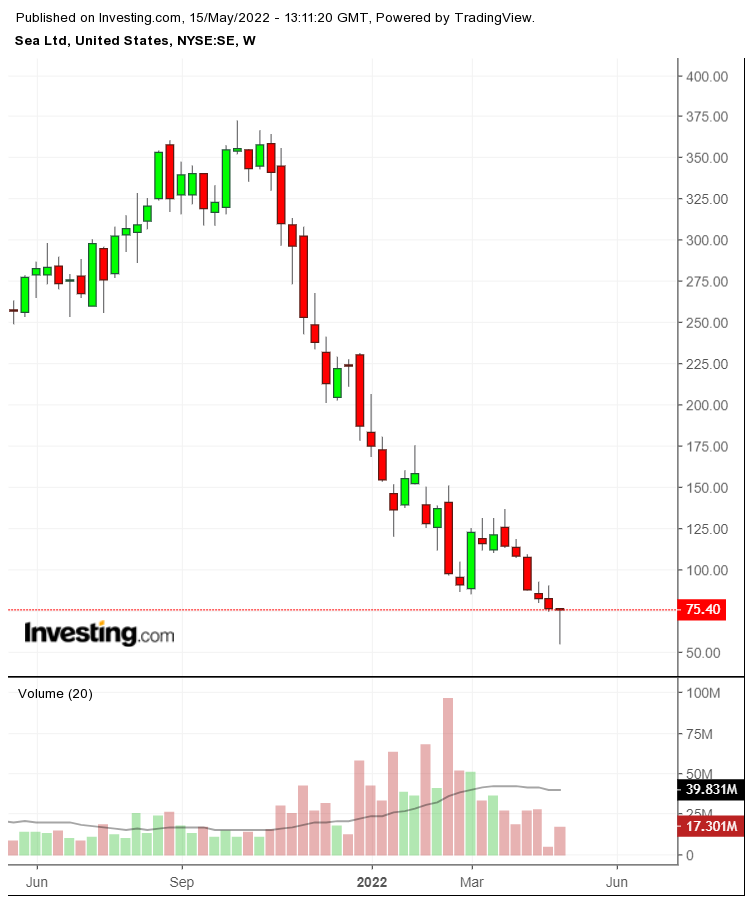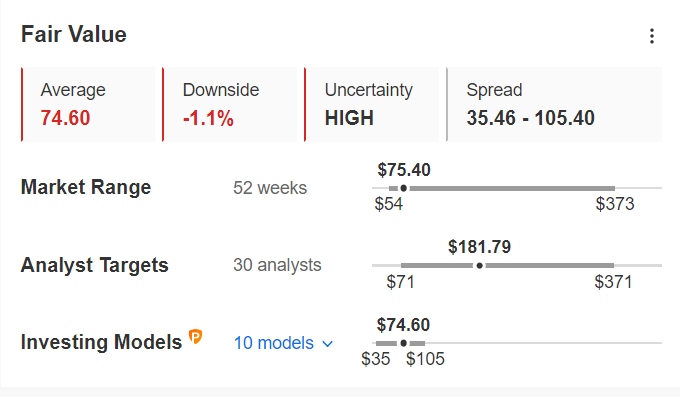- Shares of Sea have lost two-thirds of their value since January.
- Q1 results are due on May 17.
- Buy-and-hold readers could consider buying SE stock now.
- For tools, data, and content to help you make better investing decisions, try InvestingPro+.
- iShares MSCI Singapore ETF (NYSE:EWS)
- FMQQ The Next Frontier Internet & Ecommerce ETF (NYSE:FMQQ)
- VanEck Video Gaming and eSports ETF (NASDAQ:ESPO)
- ARK Fintech Innovation ETF (NYSE:ARKF)
- Roundhill Ball Metaverse ETF (NYSE:METV)
Long-term shareholders of the Southeast Asian tech name Sea (NYSE:SE) have seen the value of their investment fall by roughly 65% over the past 12 months and 66.2% year-to-date (YTD).
By comparison, the Dow Jones Internet Commerce has lost 40.0% so far this year. And the tech-heavy NASDAQ 100 Index has lost 24.1% so far this year.

Chart: Investing.com
On Oct. 19, 2021, SE shares went over $372 to hit a record high. But on May 12, they saw a multi-year low of $54.06, down over 85% from their record high value. The market capitalization (cap) currently stands at $42.2 billion.
Singapore-based Sea operates in digital entertainment, e-commerce and digital financial services sectors. The company is a well-known name in the region thanks to its popular mobile game, Free Fire, and e-commerce platform, Shopee. Through SeaMoney, it also provides digital payments and financial services.
Recent metrics point out to the strength of the Shopee app both in Singapore and in numerous countries including Taiwan, Indonesia and Brazil. For instance, “Globally, Shopee was the top ranked app in the Shopping category by downloads in the fourth quarter and for the full year of 2021.”
However, the anticipated rate hikes by the US Federal Reserve have pushed shares of many Southeast Asian tech companies lower. Sea is facing strong headwinds as global inflation increases and Covid-19 lockdowns continue to disrupt supply chains, especially in Asia.
How Recent Metrics Came
Sea released Q4 and full-year 2021 metrics on Mar. 1. Quarterly revenue increased 106% year-over-year (YoY) to $3.2 billion.
The Digital Entertainment segment boasted bookings of $1.1 billion and generated $1.4 billion in revenue, up 104% YOY. Similarly, the E-commerce segment revenue grew more than 89% to $1.6 billion. Finally, revenue for Digital Financial Services was $197.5 million, up 711.1%.
Meanwhile, Q4 net loss widened to $483.5 million, or 88 cents loss per share, compared to $430.7 million loss, or a loss of 84 cents per share in the prior-year quarter.
On the results, CEO Forrest Li stated:
“We currently expect Shopee to achieve positive adjusted EBITDA before HQ costs allocation in Southeast Asia and Taiwan by this year and SeaMoney to achieve positive cashflow by next year. As a result, we believe that by 2025, cash generated by Shopee and SeaMoney collectively will enable these two businesses to substantially self-fund their long-term growth”
For the full year 2022, management now anticipates bookings for Digital Entertainment to be between $2.9 billion and $3.1 billion. Meanwhile, revenue for E-commerce is forecast to be between $8.9 billion and $9.1 billion, and for Digital Financial Services to be between $1.1 billion and $1.3 billion.
Therefore, Q1 metrics to be released on May 17 could be a litmus test for the rest of the year. Readers should expect volatility when the company reports earnings.
Prior to the announcement of Q4 results, SE stock was changing hands at around $132. But, it is now $75.40, down more than 40%.
What To Expect From SE Stock
Among 26 analysts polled via Investing.com, SE stock has an "outperform" rating, with an average 12-month price target of $209.79 for the stock. Such a move would suggest an increase of around 178% from the current price. The target range stands between $400 and $110.

Source: Investing.com
However, according to a number of valuation models, including P/E or P/S multiples or terminal values, the average fair value for SE stock on InvestingPro stands at $74.60.

Source: InvestingPro
In other words, fundamental valuation suggests shares could decline by around 1% (or stay flat).
As part of the short-term sentiment analysis, it would be important to look at the implied volatility levels for SE options as well. Implied volatility typically shows traders the market's opinion of potential moves in a security, but it does not forecast the direction of the move.
SE’s current implied volatility is about 14% higher than the 20-day moving average. In other words, implied volatility is trending higher, while the options markets suggest increased choppiness ahead.
Our expectation is for SE stock to build a base between $65 and $85 in the coming weeks. Afterwards, shares could potentially start a new leg up.
Adding SE Stock To Portfolios
Sea Limited bulls who are not concerned about short-term volatility could consider investing now. Their target price would be $209.79, as per the target provided by analysts.
Alternatively, investors could consider buying an exchange-traded fund (ETF) that has SE stock as a holding. Examples include:
Finally, investors who expect SE stock to bounce back in the weeks ahead could consider setting up a covered call.
Most option strategies are not suitable for all retail investors. Therefore, the following discussion on SE stock is offered for educational purposes and not as an actual strategy to be followed by the average retail investor.
Covered Call On SE Stock
Price At Time Of Writing: $75.40
For every 100 shares held, the covered call strategy requires the trader to sell one call option with an expiration date at some time in the future.
Investors who believe there could be short-term profit-taking soon might use a slightly in-the-money (ITM) covered call. A call option is ITM if the market price (here, $75.40) is above the strike price ($75).
So, the investor would buy (or already own) 100 shares of SE stock at $75.40 and, at the same time, sell a SE Aug. 19 $75-strike call option. This option is currently offered at a price (or premium) of $15.90.
An option buyer would have to pay $15.90 X 100 (or $1,590) in premium to the option seller. This call option will stop trading on Friday, Aug. 19.
This premium amount belongs to the option writer (seller) no matter what happens in the future - for example, on the day of expiry.
The $75-strike offers more downside protection than an at-the-money (ATM) or out-of-the-money (OTM) call.
Assuming a trader would now enter this covered call trade at $75, at expiration, the maximum return would be $1,550, i.e., [$1,590-($75.40 - $75) X 100], excluding trading commissions and costs.
The trader realizes this gain of $1,550 as long as the price of SE stock at expiry remains above the strike price of the call option (i.e., $75 here).
At expiration, this trade would break even at the SE stock price of $59.5 (i.e., $75.40-$15.90), excluding trading commissions and costs.
On Aug. 19, if SE stock closes below $59.50, the trade would start losing money within this covered call set-up. Therefore, by selling this covered call, the investor has some protection against a potential loss. In theory, a stock's price could drop to $0.
As we have noted in numerous articles, such a covered call would limit the upside profit potential. The risk of not participating in SE stock's potential appreciation fully would not appeal to everyone. However, within their risk/return profiles, others might find that acceptable in exchange for the premium received.
